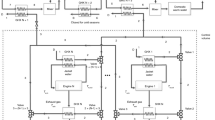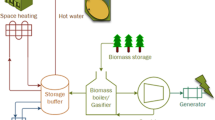Abstract
The current study presents and evaluates a new biomass-driven multi-generation system for zero energy building (ZEB) purpose. The system is aimed at providing a sample building’s electric power, hot water, heating, and cooling requirements throughout the year. The presented system is comprised of a biomass gasifier, an internal combustion engine, a water-lithium bromide double-effect absorption chiller, a backup boiler for hot water production, gas and hot water storage tanks, and heat exchangers. After introducing a pair of objective functions (namely, annual actual benefit, and loss of building requirements supply probability), the proposed system is optimized by using the modified non-dominated sorting Genetic Algorithm (NSGA-II). The results reveal that the proposed system is able to fully satisfy the building’s requirements and reach ZEB goal with the levelized cost of energy (LCOE) of about 0.19 $/kWh. A cost breakdown analysis shows that the highest and the lowest costs of the system are related to the purchase of the internal combustion engine (about 50% of total cost) and the purchase of heat exchangers (about 1% of total cost), respectively. Furthermore, a comprehensive sensitivity analysis is carried out to figure out the influence of some major economic factors on the systems annual benefit and LCOE. This analysis identifies generated electricity price conversion factors as the most influential parameters, and buying electricity cost as the least influential factor.











Similar content being viewed by others
Abbreviations
- AAB:
-
Annual actual benefit, $
- C :
-
Equipment investment cost, $
- COP :
-
Chiller operational factor
- E:
-
Electricity, W
- GS tank:
-
Gas storage tank
- H:
-
Enthalpy, \(kJ/kg\)
- HHV:
-
Higher heating value, MJ/kg
- i :
-
Interest rate, %
- LCOE:
-
Levelized cost of energy, $/kWh
- LHV:
-
Lower heating value, MJ/kg
- M :
-
Molar mass, \(g/mol\)
- MC :
-
Moisture, %
- NSGA-II:
-
Modified non-dominated sorting Genetic Algorithm
- SV :
-
Salvage value, $
- ny :
-
Lifetime
- r :
-
Number of moles
- V :
-
Volume, \(m^{3}\)
- Q :
-
Heating, J
- c :
-
Cooling
- es :
-
Selling electricity
- eb :
-
Buying electricity
- f :
-
Fuel
- h :
-
Heating
- HW :
-
Hot water
- ICE :
-
Internal combustion engine
- n :
-
Number of hour
- Nch :
-
Chiller nominal power
References
Shen, L., Sun, Y.: Performance comparisons of two system sizing approaches for net zero energy building clusters under uncertainties. Energy Build. 127, 10–21 (2016)
Ijaz Dar, U., Sartori, I., Georges, L., Nov, V.: Advanced control of heat pumps for improved flexibility of Net-ZEB towards the grid. Energy Build. 69, 74–84 (2014)
Lu, Y., Wang, S., Yan, C., Shan, K.: Impacts of renewable energy system design inputs on the performance robustness of net zero energy buildings. Energy 93, 1595–1606 (2015)
Good, C., Andresen, I., Grete Hestnes, A.: Solar energy for net zero energy buildings—a comparison between solar thermal, PV and photovoltaic–thermal (PV/T) systems. Solar Energy 122, 986–996 (2015)
Sotehi, O., Chaker, A., Maalouf, C.: Hybrid PV/T water solar collector for net zero energy building and freshwater production: A theoretical approach. Desalination 385, 1–11 (2016)
AlAjmi, A., Abou-Ziyan, H., Ghoneim, A.: Achieving annual and monthly net-zero energy of existing building in hot climate. Appl. Energy 165, 511–521 (2016)
Hirvonen, J., Kayo, G., Hasan, A., Sirén, K.: Zero energy level and economic potential of small-scale building-integrated PV with different heating systems in Nordic conditions. Appl. Energy 167, 255–269 (2016)
Marta, J.N., Panao, O.: The overall renewable energy fraction: an alternative performance indicator for evaluating net zero energy buildings. Energy Build. 127, 736–747 (2016)
Shen, L., Pu, X., Sun, Y., Chen, J.: A study on thermoelectric technology application in net zero energy buildings. Energy 113, 9–24 (2016)
Monteiro Silva, S., Mateus, R., Marques, L., Ramos, M., Almeida, M.: Contribution of the solar systems to the nZEB and ZEB design concept in Portugal—energy, economics and environmental life cycle analysis. Solar Energy Mater. Solar Cells 156, 59–74 (2016)
Bojic, M., Nikolic, N., Nikolic, D., Skerlic, J., Miletic, I.: Toward a positive-net-energy residential building in Serbian conditions. Appl. Energy 88, 2407–2419 (2011)
Almeida Dávi, G., Caamano-Martín, E., Rüther, R., Solano, J.: Energy performance evaluation of a net plus-energy residential building with grid-connected photovoltaic system in Brazil. Energy Build. 120, 19–29 (2016).
Evola, G., Margani, G., Marletta, L.: Cost-effective design solutions for low-rise residential Net ZEBs in Mediterranean climate. Energy Build. 68, 7–18 (2014)
Fiorentini, M., Cooper, P., Ma, Z.: Development and optimization of an innovative HVAC system with integrated PVT and PCM thermal storage for a net-zero energy retrofitted house. Energy Build. 94, 21–32 (2015)
Mohamed, A., Hasan, A., Sirén, K.: Fulfillment of net-zero energy building (NZEB) with four metrics in a single family house with different heating alternatives. Appl. Energy 114, 385–399 (2014)
Hassoun, A., Dincer, I.: Development of power system designs for a net zero energy house. Energy Build. 73, 120–129 (2014)
Yu, Z., Chen, J., Sun, Y., Zhang, G.: A GA-based system sizing method for net-zero energy buildingsconsidering multi-criteria performance requirements under parameter uncertainties. Energy Build. 129, 524–534 (2016)
Hamdy, M., Hasan, A., Siren, K.: A multi-stage optimization method for cost-optimal and nearly-zero-energy building solutions in line with the EPBD-recast 2010. Energy Build. 56, 189–203 (2013)
Ferrara, M., Fabrizio, E., Virgone, J., Filippi, M.: A simulation-based optimization method for cost-optimal analysis of nearly zero energy buildings. Energy Build. 84, 442–457 (2014)
Baglivo, C., Maria Congedo, P., Fazio, A., Laforgia, D.: Multi-objective optimization analysis for high efficiency external walls of zero energy buildings (ZEB) in the Mediterranean climate. Energy Build. 84, 483–492 (2014)
Gao, J., Li, A., Xu, X., Gang, W., Yan, T.: Ground heat exchangers: Applications, technology integration and potentials for zero energy buildings. Renew. Energy 128, 337–349 (2018)
Esperanza González Mahecha, R., Lucena, A.F.P., Szklo, A., Ferreira, P., Ismael A., Vaz, F.: Optimization model for evaluating on-site renewable technologies with storage in zero/nearly zero energy buildings. Energy Build. 172, 505–516 (2018).
Liu, M., Heiselberg, P.: Energy flexibility of a nearly zero-energy building with weather predictive control on a convective building energy system and evaluated with different metrics. Appl. Energy 233–234, 764–775 (2019)
Madan Ananda Kumar, L., Sivaramakrishnan, V., Premalatha, M., Vivekanandan, M.: Experimental and simulation studies on the effect of suction opening orientation on solar vertical chimney. Int. J. Sust. Energy 36, 592–605 (2015)
Serag-Eldin, M.A.: Thermal design of a modern, air-conditioned, single-floor, solar-powered desert house. Int. J. Sustain. Energy 30, 121–141 (2010)
Serag-Eldin, M.A.: Thermal design of a roof-mounted CLFR collection system for a desert absorption chiller. Int. J. Sustain. Energy 33, 506–524 (2012)
Fouad, M.M., Shihata, L.A., Mohamed, A.H.: Modeling and analysis of building attached photovoltaic integrated shading systems (BAPVIS) aiming for zero energy buildings in hot regions. J. Building Energy 21, 18–27 (2019)
Alirezaei, M., Noori, M., Tatari, O.: Getting to net zero energy building: investigating the role of vehicle to home technology. Energy Build. 13, 74–85 (2013)
Cao, S.: Comparison of the energy and environmental impact by integrating a H2 vehicle and an electric vehicle into a zero-energy building. Energy Convers Manage 123, 153–173 (2016)
Wang, J., Yang, K., Xu, Z., Fu, C.: Energy and exergy analyses of an integrated CCHP system with biomass air gasification. Appl. Energy 142, 317–327 (2015)
Puig-Arnavat, M., Bruno, J.C., Coronas, A.: Modified thermodynamic equilibrium model for biomass gasification: a study of the influence of operating conditions. Energy Fules 26, 1385–1394 (2012)
Jarungthammachote, S., Dutta, A.: Thermodynamic equilibrium model and second law analysis of a downdraft waste gasifier. Energy 32, 1660–1669 (2007)
Jayah, T.H., Aye, L., Fuller, R.J., Stewart, D.F.: Computer simulation of a downdraft wood gasifier for tea drying. Biomass Bioenergy 25, 459–569 (2003)
Melgar, A., Perrez, J.F., Laget, H., Horillo, A.: Thermochemical equilibrium modelling of a gasifying process. Energy Convers. Manage 48, 59–67 (2007)
Borji, M., Ghorbani, S., Atashkari, K., Etemadi, A.: Numerical investigation of integrated biomass gasifcation and plannar solid oxide fuel cell power plant. Amirkabir J. Mech. Eng 49(1), 219–230 (2017). (in Persian)
Puig-Arnavat, M.: Performance modelling and validation of biomass gasifiers for trigeneration plants. Universitat Rovira i Virgili, Tarragona (2011)
Zainal, Z.A., Ali, R., Lean, C.H., Seetharamu, K.N.: Prediction of performance of a downdraft gasifier using equilibrium modeling for different biomass materials. Energy Convers. Manag 42, 1499–1515 (2001)
Wang, J., Mao, T., Sui, J., Jin, H.: Modeling and performance analysis of CCHP (combined cooling, heating and power) system based on co-firing of natural gas and biomass gasification gas. Energy 93, 801–815 (2015)
Sekhar Barman, N., Ghosh, S., De, S.A.: Gasification of biomass in a fixed bed downdraft gasifier—a realistic model including tar. Bioresour. Technol. 107, 505–511 (2012)
Woo Park, C., Hee, J., Jeong, Y, Kang, T.: Energy consumption characteristics of an absorption chiller during the partial load operation. Int. J. Refrig. 27, 948–954 (2004)
Sanaye, S., Aghaei Meybodi, M., Shokrollahi, S.: Selecting the prime movers and nominal powers in combined heat and power systems. Appl. Thermal Eng. 28, 1177–1188 (2008)
Sanaye, S., Ghafurian, M.M., Tavakoli Dastjerd, F.E.: Applying relative net present or relative net future worth benefit and energy efficiency for optimum selection of a natural gas engine based CCHP system for a hotel building. J. Nat. Gas Sci. Eng., 34, 305–317 (2016)
Deb, K., Pratap, A., Agarwal, S., Meyarivan, T.A.M.T.: A fast and elitist multi objective genetic algorithm: NSGA-II. IEEE Trans. Evolut. Comput. 6, 182–197 (2002)
Deb, K.: Multi objective optimization using evolutionary algorithms, 1st edn. Wiley, New York (2001)
Coello, C.A., Lamont, G.B., Van Veldhuizen, D.A.: Evolutionary Algorithms for Solving Multi-Objective Problems, 2nd edn. Springer, New York (2002)
Satya Prasad, G.R.K.D., Vijaya Kumar Reddy, K., Saibabu, C.H.: Integration of renewable energy sources in Zero energy buildings with economical and environmental aspects by using HOMER. Int. J. Adv. Eng. Sci. Technol. 9, 212–217 (2011)
Harkouss, F., Fardoun, F., Henry Biwole, P.: Optimal design of renewable energy solution sets for net zero energy buildings. Energy 179, 1155–1175 (2019)
Author information
Authors and Affiliations
Corresponding author
Additional information
Publisher's Note
Springer Nature remains neutral with regard to jurisdictional claims in published maps and institutional affiliations.
Rights and permissions
About this article
Cite this article
Mohammadikhah, F., Javaherdeh, K. & Mahmoudimehr, J. Thermodynamic analysis and multi-objective optimization of a new biomass-driven multi-generation system for zero energy buildings. Energy Syst 12, 157–180 (2021). https://doi.org/10.1007/s12667-020-00379-8
Received:
Accepted:
Published:
Issue Date:
DOI: https://doi.org/10.1007/s12667-020-00379-8




